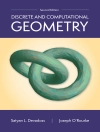The focus of this monograph is converting—reshaping—one 3D convex polyhedron to another via an operation the authors call “tailoring.” A convex polyhedron is a gem-like shape composed of flat facets, the focus of study since Plato and Euclid. The tailoring operation snips off a corner (a “vertex”) of a polyhedron and sutures closed the hole. This is akin to Johannes Kepler’s “vertex truncation, ” but differs in that the hole left by a truncated vertex is filled with new surface, whereas tailoring zips the hole closed. A powerful “gluing” theorem of A.D. Alexandrov from 1950 guarantees that, after closing the hole, the result is a new convex polyhedron. Given two convex polyhedra P, and Q inside P, repeated tailoringallows P to be reshaped to Q. Rescaling any Q to fit inside P, the result is universal: any P can be reshaped to any Q. This is one of the main theorems in Part I, with unexpected theoretical consequences.
Part II carries out a systematic study of “vertex-merging, ” a technique that can be viewed as a type of inverse operation to tailoring. Here the start is P which is gradually enlarged as much as possible, by inserting new surface along slits. In a sense, repeated vertex-merging reshapes P to be closer to planarity. One endpoint of such a process leads to P being cut up and “pasted” inside a cylinder. Then rolling the cylinder on a plane achieves an unfolding of P. The underlying subtext is a question posed by Geoffrey Shephard in 1975 and already implied by drawings by Albrecht Dürer in the 15th century: whether every convex polyhedron can be unfolded to a planar “net.” Toward this end, the authors initiate an exploration of convexity on convex polyhedra, a topic rarely studiedin the literature but with considerable promise for future development.
This monograph uncovers new research directions and reveals connections among several, apparently distant, topics in geometry: Alexandrov’s Gluing Theorem, shortest paths and cut loci, Cauchy’s Arm Lemma, domes, quasigeodesics, convexity, and algorithms throughout. The interplay between these topics and the way the main ideas develop throughout the book could make the “journey” worthwhile for students and researchers in geometry, even if not directly interested in specific topics. Parts of the material will be of interest and accessible even to undergraduates. Although the proof difficulty varies from simple to quite intricate, with some proofs spanning several chapters, many examples and 125 figures help ease the exposition and illustrate the concepts.
Содержание
I. Tailoring for Every Body.- 1. Introduction to Part I.- 2. Preliminaries.- 3. Domes and Pyramids.- 4. Tailoring via Sculpting.- 5. Pyramid Seal Graph.- 6. Algorithms for Tailoring via Sculpting.- 7. Crests.- 8. Tailoring via Flattening.- 9. Applications of Tailoring.- II. Vertex-Merging and Convexity.- 10. Introduction to Part II.- 11. Vertex-Merging Reductions and Slit Graphs.- 12. Planar Spiral Slit Tree.- 13. Convexity on Convex Polyhedra.- 14. Minimal-length Enclosing Polygon.- 15. Spiral Tree on Polyhedron.- 16. Unfolding via Slit Trees.- 17. Vertices on Quasigeodesics.- 18. Conclusions.- Bibliography.- References.- Index.
Об авторе
Joseph O’Rourke is Professor at Smith College. Prior to joining Smith in 1988 to found and chair the computer science department, Joseph O’Rourke was an assistant and then associate professor at Johns Hopkins University. His research is in the field of computational geometry. In 2001, he was awarded the NSF Director’s Award for Distinguished Teaching Scholars. He is also a professor of mathematics.
Costin Vîlcu is affiliated with the Simion Stoilow Institute of Mathematics of the Romanian Academy. His research interests include geometry of Alexandrov surfaces and intrinsic geometry of convex surfaces, including polyhedral convex surfaces.












